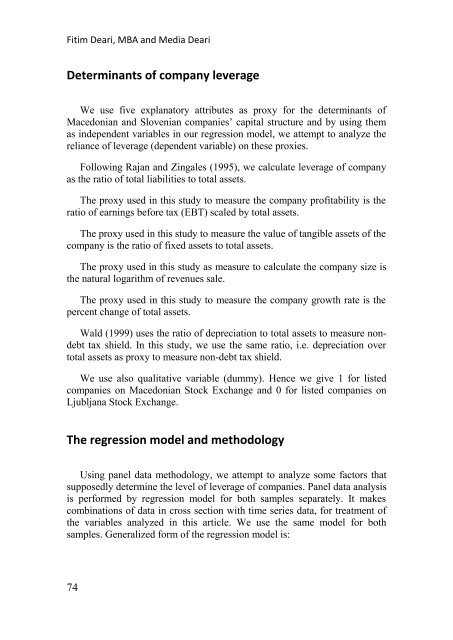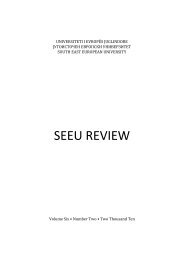SEEU Review vol. 5 Nr. 2 (pdf) - South East European University
SEEU Review vol. 5 Nr. 2 (pdf) - South East European University
SEEU Review vol. 5 Nr. 2 (pdf) - South East European University
You also want an ePaper? Increase the reach of your titles
YUMPU automatically turns print PDFs into web optimized ePapers that Google loves.
Fitim Deari, MBA and Media Deari<br />
Determinants of company leverage<br />
We use five explanatory attributes as proxy for the determinants of<br />
Macedonian and Slovenian companies’ capital structure and by using them<br />
as independent variables in our regression model, we attempt to analyze the<br />
reliance of leverage (dependent variable) on these proxies.<br />
Following Rajan and Zingales (1995), we calculate leverage of company<br />
as the ratio of total liabilities to total assets.<br />
The proxy used in this study to measure the company profitability is the<br />
ratio of earnings before tax (EBT) scaled by total assets.<br />
The proxy used in this study to measure the value of tangible assets of the<br />
company is the ratio of fixed assets to total assets.<br />
The proxy used in this study as measure to calculate the company size is<br />
the natural logarithm of revenues sale.<br />
The proxy used in this study to measure the company growth rate is the<br />
percent change of total assets.<br />
Wald (1999) uses the ratio of depreciation to total assets to measure nondebt<br />
tax shield. In this study, we use the same ratio, i.e. depreciation over<br />
total assets as proxy to measure non-debt tax shield.<br />
We use also qualitative variable (dummy). Hence we give 1 for listed<br />
companies on Macedonian Stock Exchange and 0 for listed companies on<br />
Ljubljana Stock Exchange.<br />
The regression model and methodology<br />
Using panel data methodology, we attempt to analyze some factors that<br />
supposedly determine the level of leverage of companies. Panel data analysis<br />
is performed by regression model for both samples separately. It makes<br />
combinations of data in cross section with time series data, for treatment of<br />
the variables analyzed in this article. We use the same model for both<br />
samples. Generalized form of the regression model is:<br />
74

















